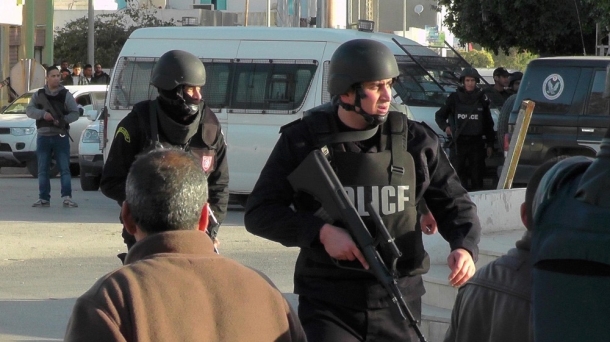
The 7 March 2016 attacks on Ben Gardane by Islamic State (IS) occurred in the context of growing upheaval in next-door Libya, internal government tension in Tunisia and challenges faced by Tunisia’s security apparatus after several armed attacks in the country during 2015. This policy brief examines the security, political and regional contexts of the Ben Gardane attack, the positive and negative aspects of the state’s response and addresses preventative measures the state is likely to take in the future.
Context
The security vacuum in which the 7 March 2016 Ben Gardane attacks occurred must be analysed while taking into consideration Tunisia’s general security, political and regional contexts. There are a number of key variables to take into account: the Islamic State (IS) or Daesh’s activities in bordering Libya, internal government tension in Tunisia (particularly within the ruling Nidaa Tounes party) and the challenges faced by the country’s security apparatus after the November 2015 bus attack on presidential guardsmen in Tunis.
The location of the Ben Gardane attack was no coincidence either. Given that it is a key border town that relies on a smuggling economy, Ben Gardane has historically been marginalized by the Tunisian state. Furthermore, the barrier built on the shared border with Libya actually hurt the city’s economy and was obviously ineffective in stopping armed attackers from infiltrating the city.
Perhaps most noteworthy, Ben Gardane’s smuggling economy means that the town is often populated with outsiders from other areas of Tunisia who go to shop for goods in the southern city. Thus, during the week it is very easy for outsiders to blend in, as they are part of the larger crowd of outsiders shopping in the city. Furthermore, it was later discovered that the planning stage of the attack was highly secretive, and that in addition to the outsiders which took part, a large number of the attackers were actually from the city.
Response
A key criticism of the response to the attack, despite security and military forces’ eventual success in killing at least fifty of the attackers and arresting at least another ten, is that there was a disconnect between the actual investigation in comparison to the quick response of soldiers and security forces on the ground. The investigation was highly criticized as both slow and ineffective, and even before the attacks took place, it was clear that internal lack of coordination within the security forces themselves meant that there was intelligence information missed – information which could have at least reduced the losses, if not outright prevented the attack from occurring.
The armed attackers had control of the city’s downtown for several hours before the security and military forces intervened, and this was partly because higher-ranking field commanders were not in the barracks and thus there was no organized and immediate response to the attack. Despite this, lower ranking commanders and soldiers eventually managed to mobilize in response, and the city’s residents also refused to cooperate with the attackers, acting as another important variable in successfully stopping the operation.
Politically speaking, the investigation into the attack was also problematic from another standpoint. Security forces, media outlets and other actors rushed to guess at the facts of the attack, ignoring whether or not these analyses were in line with reality and harming the overall credibility of the investigation.
Lessons learned and preventative measures
In the hours and days after the attacks, inhabitants of the city refused to avoid battle areas, instead preferring to participate in operations to eject Islamic State (IS) fighters from the city. Even family members of the attackers refused to hide them, and when some of these attackers were captured, it was clear from their physical appearance that they had suffered from lack of nutrition during their time on the run, meaning they had not been able to approach their family members for any support.
Thus, from an operations standpoint, security and military forces may be led to be more alert to possible suicide attacks on civilians given the Islamic State’s failed experience in Ben Gardane. The state must also re-examine the assumption that smuggling and terrorism are directly linked, instead finding ways to legitimize economic activities vital to the southern city’s livelihood.
On a more regional level, the Ben Gardane attacks may lead to better coordination between Tunisian authorities and Libyan groups controlling the border. Rather than consistently blaming Libyan factions for lack of border control after terrorist attacks, the Tunisian state may consider forming a better relationship with Libyan border factions in efforts to stop the spread of IS.
Finally, despite the state’s historic marginalization of the city, the city’s inhabitants were immensely helpful in preventing the Islamic State from establishing its stated goal of a Tunisian emirate, indicating that the citizens of the city and other, similar areas in the south, are frontline defenders against any future threats. The response of the city’s inhabitants also quashed the Islamic State’s hopes of a strong societal incubator in the south of Tunisia.